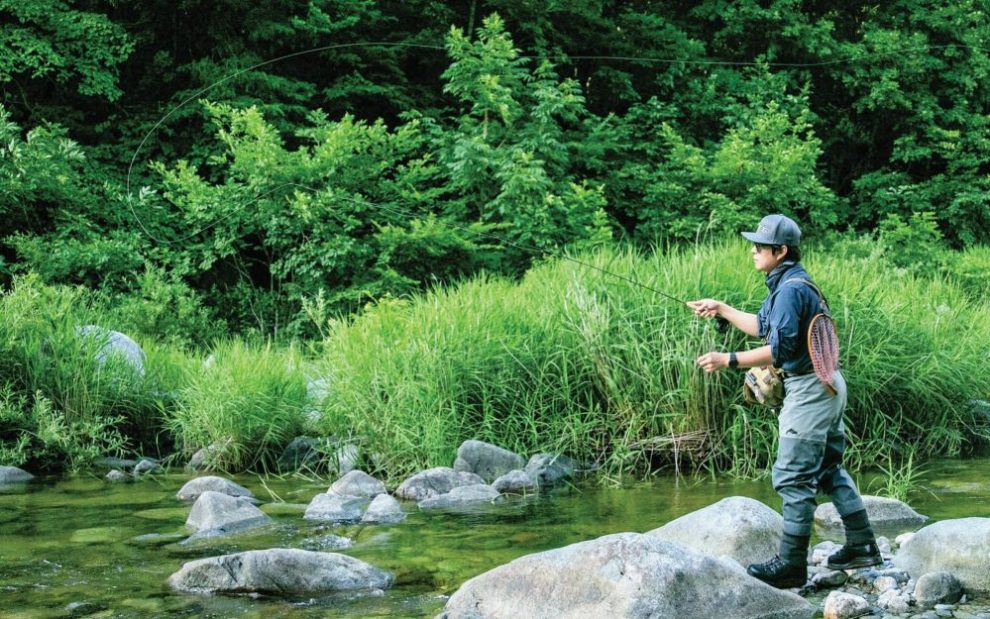When Jesus called his disciples, he promised to make them fishers of men. He also gave nautical and angling advice during his ministry. We might think of fishing as the gospel sport. And along with water and wine, loaves and fishes are canonical culinary elements.
To fish well, you need to have hope and a faith that comes short of expectation but does not sink into despair. You also need patience, judgment, and unearned grace. Fishing can be a boastful sport, inviting exaggeration and even dishonesty. Or it can bring about a heightened gratitude and awareness of the ecological blessings of nature. Yet it has also contributed to nature’s decline. Fishing also connects me to my familial past and to the land and water on which I am blessed to live in British Columbia. There is a distinctly Christian spirituality to both these realities.
The challenges of a relatively new fishery near me have brought a much-needed sense of humility that regulates and attunes my confidence as an angler. Being humbled has been the work of grace, offering me a chance to experience and grow in conversion. Unlike remote, untouched fly-in waters or heavily stocked lakes, my local fishery is heavily pressured. The top rods in the area are formidable and secretive anglers, known for hiding their catch and even their trails into spots. There are ethics related to how to treat fellow anglers, fish, and more. Never “low hole” someone by cutting below them in a run. Start above them or find a new run. Do not overplay fish for sport. This tires and even kills them. Do not photograph fish in smaller waters in a way that reveals the landscape. This puts pressure on smaller systems and can contribute to erosion or littering.
Very few resident fish are found in these clear glacial waters. The bulk are migratory, sea-run species of bull and cutthroat trout, steelhead, and five species of Pacific salmon. The latter two are the most prized. They enter the rivers to spawn so they do not eat or hunt as they would in saltwater. They cannot be caught while feeding like resident trout. These unique conditions have yielded specialized angling traditions such as the double-handed swinging of flies and spey-casting methods of the Pacific Northwest.
After a lifetime of fishing, this year has been my first time learning how to use a double-handed fly rod. These are longer and heavier than most and feature a handle below the reel, where an angler can grip the bottom of the rod to generate more casting distance and experience less fatigue. These rods cast specialized shooting lines that require an entirely different approach. They are used to fish wide, flowing rivers for steelhead and salmon with a “swinging” fly, drifted below and across the current in a sweeping motion.
When I first got my new rod and reel, the set-up intimidated me. I tried to mimic what I knew from single-hand fly casting and found the first few outings difficult, despite hours of tutorials. After a while, I was able to execute some of the steps and force a few casts out.
Finally, I sought professional help for the first time in my angling life. A local Indigenous guide, Matt Bentley, took my daughter and me out for a day of fishing. At first, I kept my new two-handed rod packed in the tube and used a single-handed rod in which I had more confidence. I caught a fine sea-run cutthroat trout and a spectacular steelhead, just in from the sea. Then it was time to humble myself and bring out my two-handed rod. Right away, Matt notified me that I had the shooting head of my line on backward.
I entered the run up to my knees in cold rushing water. “Loosen your grip on the rod. Hold it lightly, two fingers only. Slow down. Go as slow as you can. Slow. Don’t force it. Use no power. Trust your timing. Lower your hands; bring across evenly; raise them smoothly.” These commands came at me from a distance, again and again. Sometimes Matt would take my rod and show me the correct motion.
“Stop thinking. Don’t concentrate. Just let the rod do the work. And slow down!” I was working on the easiest cast, the double spey, where the rod tip lays the line on the water to position it then sweeps it in the opposite direction, gradually raising the rod tip before bending it forward with both hands, releasing the line, ending with a small grunt from the reel and landing on the water in an unfurled straight line. The hardest cast, by contrast, is the single spey. It has fewer movements and does not forgive bad timing. It is simple and demands near perfection. When it works, it shoots effortlessly like a feather from a cannon. When it fails, it falls in a limp, useless pile.
As I practice and improve, the paradox becomes apparent. When I try to use force to generate power, when I replace timing and technique with speed and coercion, I am repaid with weakness. Intensity yields low energy. Soft hands and a loose grip, with slow and deliberate movements, unlock the 100-foot cast.
When I find my rhythm, my mind turns toward reading and covering water systematically, plotting wading paths and noticing potential fish-landing hazards and opportunities, keeping an eye on my daughter fishing above me, petting my dog beside me. I can breathe. Then, just like that, I have to reset again.
I have yet to hook or land a single fish on my double-handed rod. I have also learned that some purists turn to this style of fishing to purposefully catch fewer fish and protect the rapidly decreasing populations of steelhead and salmon. At one point in my life, and even now sometimes, that seems downright stupid. But there is an intelligence to it that is not unlike the humble restraint and cultivation of weakness that this form of fishing has begun to teach me.
When Jesus told his disciples he would make them into fishers of men, he was not only using a biblical metaphor that harkened back to the prophet Jeremiah; he was also speaking to fishermen, offering them a new way to fish, fishing with a different purpose. We know that they had fishing struggles and would have understood that fishing is not the same thing as catching, but we also know that they would have understood his metaphor as a call to humanize their work as commercial anglers and become more, to find a deeper purpose and mission.
In many ways, I have been forced to abandon fishing to relearn how to cast. When I am able to perform this elementary motion, I will need to reintegrate it into fishing. The road is long and offers few guarantees. With my other rods and reels I do catch fish on occasion, but I increasingly experience them differently. I doubt I will ever become a purist, but I am thankful for the gift of a type of fishing that forces me to fish for the person I wish to become.
This article also appears in the September 2023 issue of U.S. Catholic (Vol. 88, No. 9, pages 45-46). Click here to subscribe to the magazine.
Image: Pixabay/lkk09210














Add comment